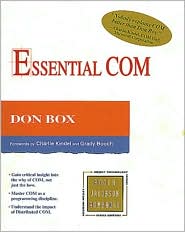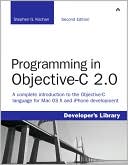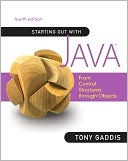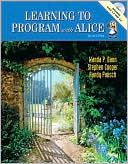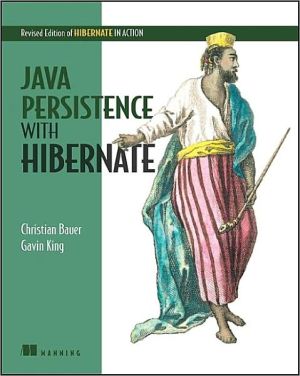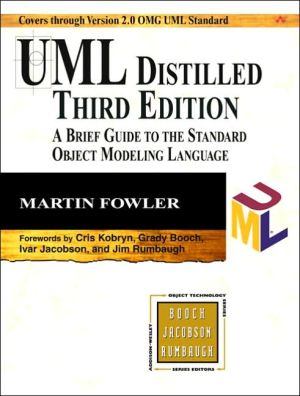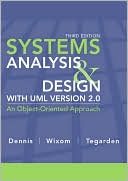Essential COM
"Don Box makes it possible for mere mortals to join the COM cognoscenti. If youire a C++ COM programmer, buy this book." -David Chappell, Principal, Chappell & Associates and author of Understanding ActiveX and OLE\ Written by a leading COM authority, this unique book reveals the essence of COM, helping developers to truly understand the why, not just the how, of COM. Understanding the motivation for the design of COM and its distributed aspects is critical for developers who wish to go...
Search in google:
"Don Box makes it possible for mere mortals to join the COM cognoscenti. If youire a C++ COM programmer, buy this book." -David Chappell, Principal, Chappell & Associates and author of Understanding ActiveX and OLEWritten by a leading COM authority, this unique book reveals the essence of COM, helping developers to truly understand the why, not just the how, of COM. Understanding the motivation for the design of COM and its distributed aspects is critical for developers who wish to go beyond simplistic applications of COM and become truly effective COM programmers. As the COM programming model continues to evolve, such insight also becomes essential to remaining current with extensions, such as Microsoft Transaction Server and COM+. By showing you why Distributed COM works as it does, Don Box enables you to apply the model creatively and effectively to everyday programming problems.This book examines COM from the perspective of a C++ developer, offering a familiar frame of reference to ease you into the topic. You will also find comprehensive coverage of the core concepts of Distributed COM (interfaces, classes, apartments, and applications), including detailed descriptions of COM theory, the C++ language mapping, COM IDL (Interface Definition Language), the remoting architecture, IUnknown, monikers, threads, marshalers, security, and more. In addition, the book offers a thorough explanation of COMis basic vocabulary, provides a complete Distributed COM application to illustrate programming techniques, and includes the authoris tested library of COM utility code. Marcato The Ultimate COM Reference The Component Object Model (better known simply as COM) is Microsoft’s response to the increasing need for a solid foundation onto which modular software components can be built and upon which they can interact. Centered on the principle of separation between interface and implementation, COM achieves truly effective component-based management and language independence by defining not only a binary standard, but also a set of mandatory rules and design/implementation idioms that allow components to expose their functionality in a consistent manner. The paradigm abstracts the physical location of the objects; thus, with DCOM (Distributed COM), clients and servers can almost transparently reside in any nodes of a network. Starting from the progressive definition of an informal set of requirements for modular software architectures, the first chapter of Essential COM highlights how, by itself, the C++ language is not capable of satisfying many of them, even when associated with DLLs. Several possible design alternatives are then evaluated, and the final decision leads to the rough engineering of COM. This is perhaps the most vaporware-free introduction to the subject I have ever read because it explains through facts and not conjecture how and why the C++ object model maps well to COM. The following chapter dives straight into the core of COM by clearly explaining the key notion of interfaces (including the root of all of them, IUnknown), the rules to which they must adhere, and the way they should be described in IDL (Interface Definition Language). The subsequent chapters focus on the other fundamental aspects of the paradigm: coclasses, monikers, object identity, marshaling, apartments, security. Although DCOM is not cited explicitly in the title, the presentation of object activation and of the apartment models takes into account the distributed case from the beginning, instead of delegating such discussion to a final chapter as many other books not specifically focused on distributed architectures do. As the book proceeds, more and more room is given to complex technical issues and useful (while not trivial) COM programming idioms, such as tear-off interfaces for saving memory as the number of interfaces climbs significantly but not all of them happen to be constantly in use. In all cases the solutions make use of only the raw COM API and interfaces at the C++ level. Neither the theory, nor any of the numerous code snippets sprinkled throughout in the book, mention high-level frameworks such as ATL or MFC. The dissertation on multithreading issues and marshaling are very detailed and betray the vast experience of the author in the implementation of nontrivial COM systems. Let me state clearly that this is not an easy read. The density of the book (calculated as actual information per page) is incredibly high and, while a rare quality in today’s books, it requires particular concentration to be digested. The editing is overall of good level, although the writing style in certain parts becomes a little heavy and academic, which does not help overcome the toughest conceptual barriers of certain topics. Additional diagrams would have aided comprehension, too. In the preface the author himself admits he took the style of the notorious book, The C++ Programming Language (authored by the equally notorious Bjarne Stroustrup) as inspiration. Although one covers a single object-oriented programming language and the other a language- independent object-oriented paradigm, I believe the comparison is apt. Just as Stroustrup’s text is widely considered the definitive reference for C++ for its depth and completeness, so Essential COM deserves to be elected the definitive reference for COM due to the same outstanding quality. The emphasis is on amassing a solid ground on the so-called COM lifestyle and on understanding how and why to opt for certain techniques rather than the other possible approaches to both common and advanced problems. If you are looking for a book that exposes up front to the reader ATL or MFC code snippets to cut and paste into his or her ongoing ActiveX project, look elsewhere. When you have read this however, rest assured that you will be able to benefit from such other hands-on books immensely more. Also, following up the previous observation, just as I would be reluctant to suggest Stroustrup’s book to someone who is going to meet C++ for the first time, I wouldn’t suggest COM illiterates to begin their explorations from this one, unless they knew C++ and another distributed model like CORBA quite well. Other books on the marketplace take a milder approach while attempting to explain basically the same subject. They generally fall short of deep technical details and advanced facets, nonetheless they can offer a somewhat more progressive path to the complexity of the argument. One such book that I would suggest is Inside COM, written by Dale Rogerson and published by Microsoft Press. Unfortunately other COM/DCOM correlated topics, such as MTS and COM+, are not even touched. It could be objected that it is not the goal of this book to offer quick-and-dirty overviews of anything, but an indication of where those new acronyms integrate in the big picture would have been interesting in my opinion.--Dr. Dobb's Electronic Review of Computer Books
My work is done.\ I can finally rest, knowing that I have finally put into writing what many have termed the rich oral history of COM. This book reflects the evolution of my own understanding of this rogue technology that Microsoft was kind enough to reveal to the programming world in 1993. While I did not attend the original OLE Professional Developer's Conference, I still feel as if I have been doing COM forever. After almost four years of working with COM, I can barely remember the pre-COM era of computing. I can, however, vividly remember my own painful trek across the COM landscape in early 1994.\ It took me roughly six months before I felt I understood anything about COM. During this initial six-month period of working with COM, I could successfully write COM programs and almost explain why they worked. However, I had no organic understanding of why the COM programming model was the way it was. Fortunately, one day (August 8, 1994, roughly six months after buying the book Inside OLE2), I had an intense epiphany and at once COM seemed obvious to me. This by no means meant that I understood every COM interface and API function, but rather, that I understood the primary motivating factors behind COM. From this, it became clear how to apply the programming model to everyday programming problems. Many other developers have related similar experiences to me. As I write this preface three Augusts after the fact, developers still must go through this six-month waiting period prior to becoming productive members of COM society. I would like to think that this book might shorten that time period, but I make no promises.\ As this book emphasizes, COM is more a programming discipline than a technology. To this end, I have attempted to not bludgeon the reader with detailed descriptions of each parameter to each method from each interface. Rather, I have tried to distill the essence of what COM is really about, leaving the SDK documentation to fill in the gaps left behind by each chapter. Wherever possible, I have attempted to address the underlying tensions that motivate a particular aspect of COM rather than provide detailed examples of how to apply each interface and API function to a contrived example program. My own experience has shown that once the why is understood, the how follows fairly naturally. Conversely, simply knowing the how rarely provides adequate insight to extrapolate beyond the documentation. This insight is critical if one hopes to keep up with the programming model's continual evolution.\ COM is an extremely flexible substrate for building distributed object-oriented systems. To take advantage of COM's flexibility, one must often think outside the constraints of the SDK documentation, articles or books. My personal recommendation is to assume that anything you read (including this book) may be incorrect or woefully out of date and instead form your own personal understanding of the programming model. The surest way to understand the programming model is to focus on mastering the basic vocabulary of COM. This can only be accomplished through writing COM programs and analyzing why those programs work the way they work. Reading books, articles and documentation can help, but ultimately, dedicating the time to contemplate the four core concepts of COM (interfaces, classes, apartments and security) can only enhance your effectiveness as a COM developer.\ To help the reader focus on these core concepts, I have tried to include as much code as possible without explicitly providing elaborate implementations for the reader to simply copy into their own source code. To ensure that COM programming techniques are also presented in context, Appendix B contains one complete COM application that is an example of many of the concepts discussed throughout the book. Additionally, Appendix B contains a library of COM utility code that I have found useful in my own development. Some parts of this library are discussed in the book in detail, but the entire library is included as a demonstration of how to architect de facto C++ implementations. Also note that much of the code that appears in each chapter uses the C runtime library macro assert to emphasize that certain pre- or post-conditions must be met. In production code, many of these assert statements should be replaced with somewhat more forgiving error handling code.\ One downside of published books is that they are often obsolete by the time they arrive at the local bookstore. This book is no different. In particular, the pending release of COM+ and Windows NT 5.0 will certainly render various aspects of this book incorrect or at least incomplete. I have tried to anticipate the evolution of the model imposed by the release of Windows NT 5.0, however, at the time of this writing, Windows NT 5.0 has not yet entered its public beta cycle and all information is subject to change. COM+ promises to evolve the model even further, however, it was impossible to include COM+ coverage and still deliver my manuscript this year. I highly encourage you to investigate both Windows NT 5.0 and COM+ when they become available.\ One rather painful decision I had to make was how to address the various commercial libraries used to implement COM components in C++. After observing the common questions that appear on various Internet newsgroups, I elected to ignore ATL (and MFC) and instead focus on the bread-and-butter topics of COM that every developer must master irrespective of the library used. More and more developers are generating ATL spaghetti and wondering why things don't work. I firmly believe one cannot learn COM by programming in ATL or MFC. This does not mean that ATL and MFC are not useful tools for developing COM components. It simply means that they are not suited to demonstrating or learning COM programming concepts and techniques. This makes ATL inappropriate for a book focused on the COM programming model. Fortunately, most developers find that once COM is understood, the basics of ATL can be mastered in short order.\ Finally, the quotes that begin each chapter are a chance for me to write whatever I felt like for a small section of the book. In an effort to keep my writing as direct as possible, I restricted my wild off-topic stories to no more than 15 lines of C++ code per chapter. Usually, the code/quote represents the pre-COM approach to a problem or concept presented in the chapter. I leave it as an exercise for the reader to deconstruct my state of mind when writing a particular chapter based on these hints.\ Acknowledgements\ Writing a book is incredibly hard, at least it was for me. Two people who I know for certain suffered more than I did were my patient wife Barbara and my tolerant son Max (who prefers COM to other object models despite his youth). To both of you, thanks for tolerating my absence and generally cranky disposition while I tried to write. Fortunately, my freshly-instantiated daughter Evan was born after the bulk of this book was written and has had a fairly present and pleasant father. A related thanks goes out to all the staffers at DevelopMentor who had to cover for me when I "went dark" to crank out chapters.\ A lot of my early thinking about distributed systems was formed working for Tatsuya Suda at UC Irvine in the early 1990's. Tatsuya taught me how to write, how to read, and how to deal with unruly train passengers in Tokyo. Thanks and sorry.\ Thanks to my old office-mate Doug Schmidt for introducing me to Stan Lippman at the C++ Report. Despite Stan's rousing rejection of my first article, I first got my name in lights thanks to you two. Thanks to Mike Hendrickson and Alan Feuer at Addison Wesley for getting this project started. Thanks to Ben Ryan and John Waite for being patient. Thanks to the folks at Microsoft Systems Journal who tolerated my late submissions during the production of this book. In particular, thanks to Joanne Steinhart, Gretchen Bilson, Dave Edson, Joe Flanigen, Eric Maffei, Michael Longacre, Joshua Trupin, Laura Euler, and Joan Levinson. I promise never to be late again.\ Thanks to David Chappell for writing the finest book on COM available. I heartily recommend that everyone buy a copy and read it at least twice. Thanks to the CORBA and Java partisans and zealots who have engaged me in flame-wars on various Usenet newsgroups over the years. Your constant vigilance has made my own understanding of COM infinitely better. Despite the fact that I still feel many of your arguments are specious and somewhat Martian, I respect your desire to survive.\ Several people at Microsoft proper have been very helpful to me over the years and either directly or indirectly helped me write this book. Sara Williams was the first COM person from Microsoft I had ever met. Right after explaining that she didn't know Bill all that well, she introduced me to Gretchen Bilson and Eric Maffei at Microsoft Systems Journal as consolation. Sara has always been a great "Box Evangelist" within the big house and I am forever grateful. Charlie Kindel wrote the nice forward to my book despite his heavy schedule and exceedingly regular trips to the barber. Nat Brown was the first person to show me apartments and has irrevocably polluted my vocabulary with the word "schwing." Kraig Brockschmidt explained to me that one particular aspect of COM that looks incredibly elegant was actually a grotesque last-minute hack. Dave Reed introduced me to Viper and listens to my clams each time I visit Redmond. Pat Helland spent the entire week of TechEd 97 twisting my brain and forcing me to reexamine most of my basic assumptions about COM. Scott Robinson, Andreas Luther, Markus Horstmann, Mary Kirtland, Rebecca Norlander, and Greg Hope have been great at keeping me out of the dark. Ted Hase helped me spread the word. Rick Hill and Alex Armanasu did a great job watching my back on the technical front. Other Microsoft people who have influenced my work through their own include Tony Williams, Bob Atkinson, Craig Whittenberg, Crispin Goswell, Paul Leach, David Kays, Jim Springfield, Christian Beaumont, Mario Goertzel, and Michael Montague.\ The DCOM mail reflector has been a great source of inspiration and ideas for this book. Special thanks go to the following DCOM-listers: the infamous Mark Ryland, COM wunderkind Mike Nelson, Keith Brown, Tim Ewald, Chris Sells, Saji Abraham, Henk De Koenig, Steve Robinson, Anton von Stratten and Randy Puttick. The story in this book has been greatly influenced by my teaching COM at DevelopMentor for the past several years. The story has been shaped as much by the students as it has by my fellow instructors. While I wish I could thank every student personally (Addison Wesley has limited my preface to less than 20 pages), I can thank the current set of DevelopMentor-ites who have helped me refine my own understanding by teaching our Essential COM course and providing invaluable feedback: Ron Sumida, Fritz Onion, Scott Butler, Owen Tallman, George Shepherd, Ted Pattison, Keith Brown, Tim Ewald and Chris Sells. Thanks guys! Thanks also to Mike Abercrombie of DevelopMentor for creating an environment where personal growth isn't stiffled by commerce.\ This book would have been released considerably earlier had it not been for Terry Kennedy and friends at Software AG. Terry was nice enough to invite me to help with the DCOM/UNIX effort in Germany during the sabbatical I had initially carved out to write the book. While this book is a year late because I couldn't say no to Terry (this is my fault, not Terry's), I think that the book is infinitely better due to the time I spent working on the project. In particular, I gained many insights working with Harald Stiehl, Winnie Froehlich, Volker Denkhaus, Deitmar Gaertner, Jeff Lee, Deiter Kesler, Martin Koch, Blauer Afe, and the notorious Thomas Vogler. Finally, thanks to Shah Jehan and the Coca-Cola Corporation for fueling this effort by respectively producing the most delicious Indian food and soft drinks available.\ Don Box Redondo Beach, CA August 1997\ http://www.develop.com/dbox
Foreword by Charlie Kindel.Foreword by Grady Booch.Preface.1. COM as a Better C++.Software Distribution and C++.Dynamic Linking and C++.C++ and Portability.Encapsulation and C++.Separating Interface from Implementation.Abstract Bases as Binary Interfaces.Runtime Polymorphism.Object Extensibility.Resource Management.Where Are We?2. Interfaces.Interfaces and Implementations Revisited.IDL.Methods and Results.Interfaces and IDL.Iunknown.Resource Management and Iunknown.Type Coercion and Iunknown.Implementing Iunknown.Using COM Interface Pointers.Optimizing QueryInterface.Data Types.Attributes and Properties.Exceptions.Where Are We?3. Classes.Interface and Implementation.Class Objects.Activation.Using the SCM.Classes and Servers.Generalizations.Optimizations.Interface and Implementation Again.Monikers and Composition.Monikers and Persistence.Server Lifetime.Classes and IDL.Class Emulation.Competent Categories.Where Are We?4. Objects.IUnknown Revisited.QueryInterface Is Symmetric.QueryInterface Is Transitive.QueryInterface Is Reflexive.Objects Have Static Type.QueryInterface and Iunknown.Uniqueness and Identity.Multiple Interfaces and Method Names.Dynamic Composition.Binary Composition.Containment.Where Are We?5. Apartments.Interface and Implementation Revisited.Objects, Interfaces, and Apartments.Cross-Apartment Access.In-Process Marshaling Helpers.Standard Marshaling Architecture.Lifecycle Managing and Marshaling.Custom Marshaling.The Free Threaded Marshaler.Where Are We?6. Applications.In-Process Activation Pitfalls.Activation and the SCM.Server Lifetime Revisited.Application Ids.COM and Security.Programmatic Security.Access Control.Token Management.Where Are We?7. Miscellanea.Pointer Basics.Pointers and Memory.Arrays.Flow Control.Dynamic versus Static Invocation.Bidirectional Interface Contracts.Aliasing in IDL.Asynchronous Methods.Where Are We?Appendix A. The Evolution of Objects.Appendix B. Selected Code Fragments.Index.
\ MarcatoThe Ultimate COM Reference\ The Component Object Model (better known simply as COM) is Microsoft's response to the increasing need for a solid foundation onto which modular software components can be built and upon which they can interact. Centered on the principle of separation between interface and implementation, COM achieves truly effective component-based management and language independence by defining not only a binary standard, but also a set of mandatory rules and design/implementation idioms that allow components to expose their functionality in a consistent manner. The paradigm abstracts the physical location of the objects; thus, with DCOM (Distributed COM), clients and servers can almost transparently reside in any nodes of a network.\ Starting from the progressive definition of an informal set of requirements for modular software architectures, the first chapter of Essential COM highlights how, by itself, the C++ language is not capable of satisfying many of them, even when associated with DLLs. Several possible design alternatives are then evaluated, and the final decision leads to the rough engineering of COM. This is perhaps the most vaporware-free introduction to the subject I have ever read because it explains through facts and not conjecture how and why the C++ object model maps well to COM.\ The following chapter dives straight into the core of COM by clearly explaining the key notion of interfaces (including the root of all of them, IUnknown), the rules to which they must adhere, and the way they should be described in IDL (Interface Definition Language). The subsequent chapters focus on the other fundamental aspects of the paradigm: coclasses, monikers, object identity, marshaling, apartments, security. Although DCOM is not cited explicitly in the title, the presentation of object activation and of the apartment models takes into account the distributed case from the beginning, instead of delegating such discussion to a final chapter as many other books not specifically focused on distributed architectures do.\ As the book proceeds, more and more room is given to complex technical issues and useful (while not trivial) COM programming idioms, such as tear-off interfaces for saving memory as the number of interfaces climbs significantly but not all of them happen to be constantly in use. In all cases the solutions make use of only the raw COM API and interfaces at the C++ level. Neither the theory, nor any of the numerous code snippets sprinkled throughout in the book, mention high-level frameworks such as ATL or MFC. The dissertation on multithreading issues and marshaling are very detailed and betray the vast experience of the author in the implementation of nontrivial COM systems.\ Let me state clearly that this is not an easy read. The density of the book (calculated as actual information per page) is incredibly high and, while a rare quality in today's books, it requires particular concentration to be digested. The editing is overall of good level, although the writing style in certain parts becomes a little heavy and academic, which does not help overcome the toughest conceptual barriers of certain topics. Additional diagrams would have aided comprehension, too.\ In the preface the author himself admits he took the style of the notorious book, The C++ Programming Language (authored by the equally notorious Bjarne Stroustrup) as inspiration. Although one covers a single object-oriented programming language and the other a language- independent object-oriented paradigm, I believe the comparison is apt. Just as Stroustrup's text is widely considered the definitive reference for C++ for its depth and completeness, so Essential COM deserves to be elected the definitive reference for COM due to the same outstanding quality.\ The emphasis is on amassing a solid ground on the so-called COM lifestyle and on understanding how and why to opt for certain techniques rather than the other possible approaches to both common and advanced problems. If you are looking for a book that exposes up front to the reader ATL or MFC code snippets to cut and paste into his or her ongoing ActiveX project, look elsewhere. When you have read this however, rest assured that you will be able to benefit from such other hands-on books immensely more.\ Also, following up the previous observation, just as I would be reluctant to suggest Stroustrup's book to someone who is going to meet C++ for the first time, I wouldn't suggest COM illiterates to begin their explorations from this one, unless they knew C++ and another distributed model like CORBA quite well. Other books on the marketplace take a milder approach while attempting to explain basically the same subject. They generally fall short of deep technical details and advanced facets, nonetheless they can offer a somewhat more progressive path to the complexity of the argument. One such book that I would suggest is Inside COM, written by Dale Rogerson and published by Microsoft Press.\ Unfortunately other COM/DCOM correlated topics, such as MTS and COM+, are not even touched. It could be objected that it is not the goal of this book to offer quick-and-dirty overviews of anything, but an indication of where those new acronyms integrate in the big picture would have been interesting in my opinion.--Dr. Dobb's Electronic Review of Computer Books\ \ \
